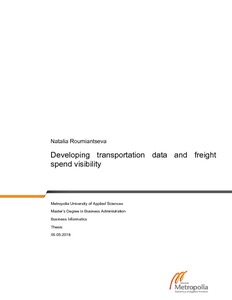Developing transportation data and freight spend visibility
Roumiantseva, Natalia (2018)
Roumiantseva, Natalia
Metropolia Ammattikorkeakoulu
2018
All rights reserved
Julkaisun pysyvä osoite on
https://urn.fi/URN:NBN:fi:amk-2018053111627
https://urn.fi/URN:NBN:fi:amk-2018053111627
Tiivistelmä
The global shipping environment is continuously quickly changing, which means that shippers have to stay up-to-date on the latest trends and even a step aheard to keep pace. The control of transportation costs, which is often the largest component of total logistics spend is an increasingly important area where the companies should focus when looking for competitive advantage. Managers require more accurate and focused transportation and freight spend data as well as forecasts for preserving margins and profitability as well as improving supply chain performance. A large number of companies with significant transportation spend are unable to aggregate all of their shipping data into one location for analysis by the management. It is an issue in my case company as well, which is examined in this thesis.
The objective of this study is to produce an approach to improve transportation data and freight spend visibility and give an opportunity of quickly get spend information, to do a costs analysis and projections for the future. The outcome of the work is a list of recommendations for the case company to follow in order to reach the objective. The case company is chosen from the pharmaceutical industry.
An action research is conducted in the organization. I have investigated the current state of the case company's transportation data and freight spend management and data sources to gain insights from strengths and weaknesses of the present process, including the experience and practices in the company’s other business units. As a theoretical background, the best practices of freight spend management were studied as well as the latest trends in modern technology – business intelligence tools solution for deploying predictive analytics and for building the necessary data visualization, to form an idea what could be improvement steps for my case company. In order to strengthen the conceptual framework I have undertaken interviews with practitioners – specialists and experts in the logistics field.
Based on the analysis of the current state and the best practices in the field, a list of recommendations was prepared and some highly important issues and processes defined as needed to be refined before or in parallel with the main suggested steps towards this work objective. The recommendations were positively met by the informants and taken into use as a part of the immediate and long-term continuous improvement projects.
The objective of this study is to produce an approach to improve transportation data and freight spend visibility and give an opportunity of quickly get spend information, to do a costs analysis and projections for the future. The outcome of the work is a list of recommendations for the case company to follow in order to reach the objective. The case company is chosen from the pharmaceutical industry.
An action research is conducted in the organization. I have investigated the current state of the case company's transportation data and freight spend management and data sources to gain insights from strengths and weaknesses of the present process, including the experience and practices in the company’s other business units. As a theoretical background, the best practices of freight spend management were studied as well as the latest trends in modern technology – business intelligence tools solution for deploying predictive analytics and for building the necessary data visualization, to form an idea what could be improvement steps for my case company. In order to strengthen the conceptual framework I have undertaken interviews with practitioners – specialists and experts in the logistics field.
Based on the analysis of the current state and the best practices in the field, a list of recommendations was prepared and some highly important issues and processes defined as needed to be refined before or in parallel with the main suggested steps towards this work objective. The recommendations were positively met by the informants and taken into use as a part of the immediate and long-term continuous improvement projects.
